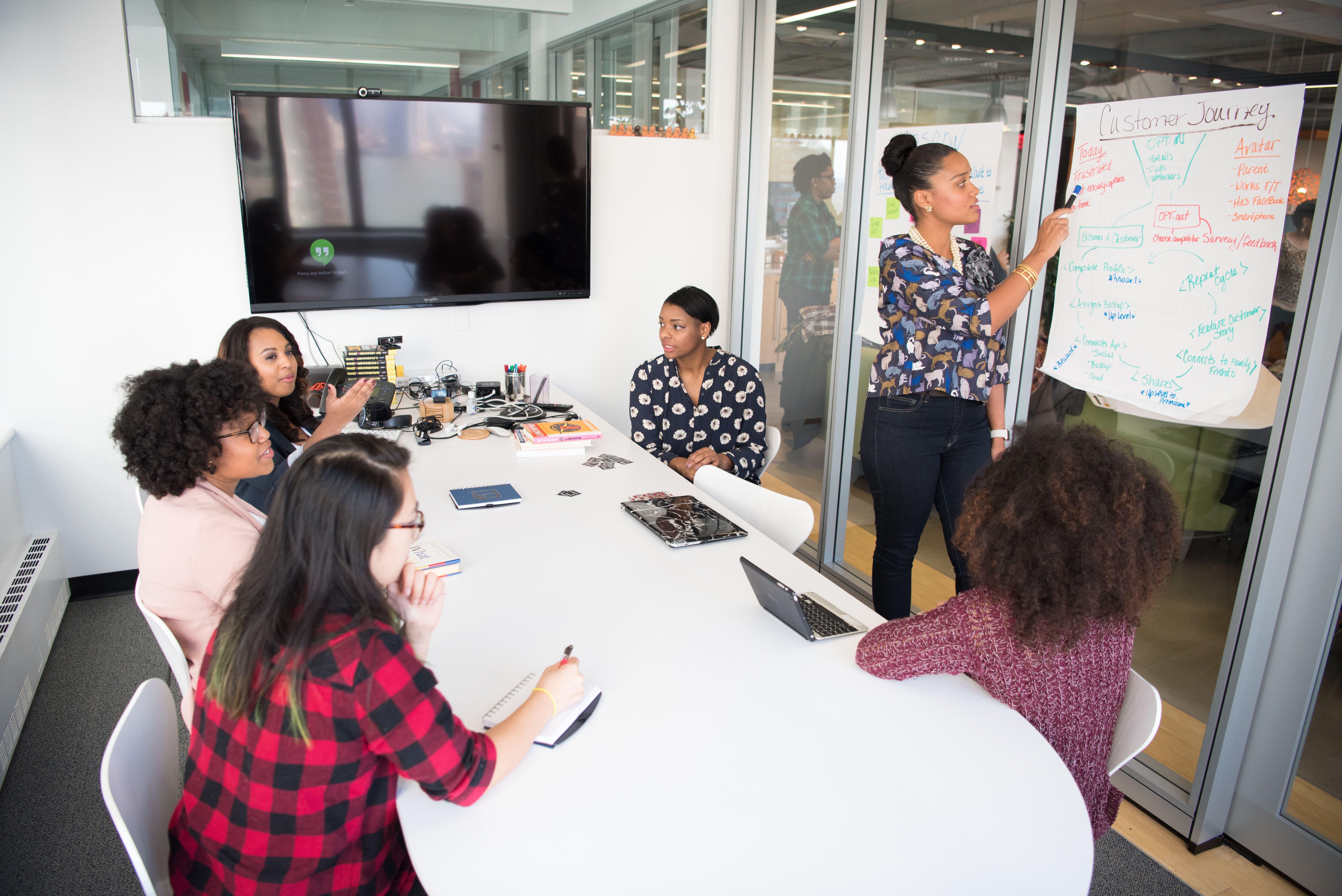Human beings on both sides of the screen
Both teachers and students live the experience of virtual education as human beings. It is a rich, deep, complex experience that transcends the content we are sharing. It is not obvious.
Having the screen in front of you can produce the idea that it is an impersonal form of education, but it is not. The richness is all in interaction and in both the synchronous and non-synchronous sessions, we have to do our best to remember that the interaction is established between human beings with expectations, talents, dreams, interests and ideals.

Reducing the ethical challenges of virtual education to plagiarism or to the discussion of whether or not students activate their cameras exposes the need of control in a hierarchical approach to learning. In my opinion, this position considerably limits the human experience in virtual education. This experience is based on both ethical and pedagogical values. It is the teacher’s responsibility to create dynamics that address this reality.
Acknowledging that there are people on both sides of the screen must go hand in hand with the development of creative and non-coercive pedagogical designs. Questions cannot have an obvious, predictable answer. Activities should promote the human experience in all its richness. If we do that, issues such as plagiarism or the activation of our students’ cameras will not be relevant.
Institutional change For an anti-racist school
Anti-racist educators struggle with their beliefs, mentalities, philosophies and prejudices about the world, education and their students. When I was invited by a public school in Brazil to help them plan an anti-racist strategy, I felt that I could not deny my voice, as Paulo Freire would say. Despite this, I felt insecure. I am not a researcher on racial issues and I have been away from Brazil’s racial reality for 15 years. In addition, a question hung around my mind. A question that may speak of the racism that exists within me, but I have to say, I formulate it with sincerity:
Am I black enough to do this job?
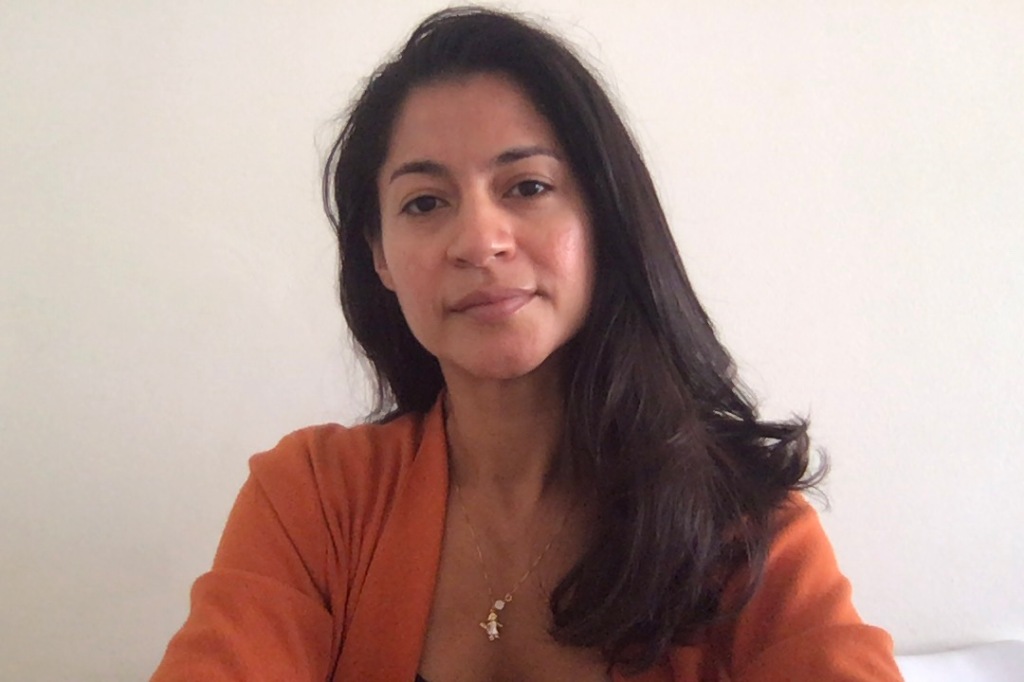
If I had been born in the United States, there would be no doubt. I’m black. In the Brazilian contexts, where I was born, and in Spain, where I currently live, when I identify myself as black, people look at me with a half smile, almost forgiving my innocence. When I read the reports of so many black people who suffer micro and macro aggression for their racial condition in the #blacklivesmatter movement, I thought that maybe I wasn’t really that black. These heartbreaking, moving accounts I read on Twitter made me reflect on my own history. Aside from some anecdote, I don’t have any moving reports of racism to share. For all these reasons, when this school invited me to help its team to reflect on racism and perhaps start an anti-racist work, I was afraid, but I also felt challenged to do something. Could I just say, “No, thanks” and sleep softly? I couldn’t.
This is the context for elaborating the conversation to open the “Pandora’s Box” at a public school in Belo Horizonte, Brazil. The whole conversation was based on questions. The team answered the questions and we all analyzed the results shared anonymously by the group. For me it was very important to help understand that the work for an anti-racist education begins within each one of us. The first question was “Am I racist?” 57% of the group answered that they were not, they were not racists. But 100% of the group believed that Brazil is not that racial democracy that they spread and 97% of the group knew racist people. In the conversation, we began to realize that we are under the illusion that racism is something out there, a problem of the others. But it’s not like that.
When it came time to share situations in which racism is expressed in each of us, things like this came out:
“I would like my hair to be straight.”
“I am not attracted to black men.”
“I’m dating a black man and I’m afraid of my family’s reaction.”
We also realize that racism is present at the school. A teacher recalled that when parties are organized where students dance in couples, black children are always the last to get a pair. It was a frank conversation. A black teacher, a master’s student in African History, reported her struggle at school. She explained that she felt alone in the anti-racist struggle, as if this were a theme for her, cause she was black, but not something that everyone should face together.
I feel moved remembering this conversation and that’s why I had to share it here. I was certainly not the best person to talk about racism, but I left the staff at that school organizing study groups on anti-racism and preparing teaching units in teams to highlight black characters in different fields of knowledge and culture.
Little by little I learn that when someone invites me to speak, they don’t just want to listen. I can’t just talk to people anymore. I need to listen to them. I cannot deny my voice, but my voice needs their voices to make sense.
Educators’ digital identity
We must overcome the view that there is a separate and independent virtual world and a physical world, as if the physical world were the “real thing” and in the virtual world there where “we are free”. Reality is everything: the physical (analog) and the virtual (digital). Both what we do in the virtual world and what we share in the physical world shape who we are, express values, and give reality our personal nuance.
Digital identity is made up of every word, image, audio or video we share on the Internet. This is done through social media, but also on blogs, websites, forums, you tube channels, online games, and more.
The freedom to say what one wants or to be as it is in the virtual world has conditions that deserve reflection and action:
First: ALL messages, images or videos that an educator shares on the Internet, as well as in the physical world, must be based on values of respect, tolerance and commitment to a more just and supportive world. Assertiveness thus becomes a communicative goal that educators must aspire to in all the interactions they establish, whether in the physical world or in the virtual world.
Second: We can and must defend ideals and be active in the virtual world, always with the awareness that our learners, their families and the companies where we will work see us, read us and listen to us.
In short, it is a matter of understanding that our digital identity speaks of who we are and exposes us to the world. Being aware of this determines every image shared, every like, every comment we make on the Internet.

I’m loving it
My students take different degrees of Education at the Rovira i Virgili University. The pamdemic has thrown the teaching team of the Communication Skills course out of our comfort zone. We have worked hard and lovingly to make our teaching an online experience that is useful, challenging, and enriching for our students.
For now I will tell you about the initial activity – OMG! Can’t believe this is just beginning! I am astonished at what is coming to light … We have used Flipped Grid to ask our students to present themselves through an object. They had to choose an object and explain why it could represent them. Couldn’t be simpler, right? So far…
- 159 responses
- 39.088 views
- 258 comments
- 827.9 hours of engagement
Can you believe it?
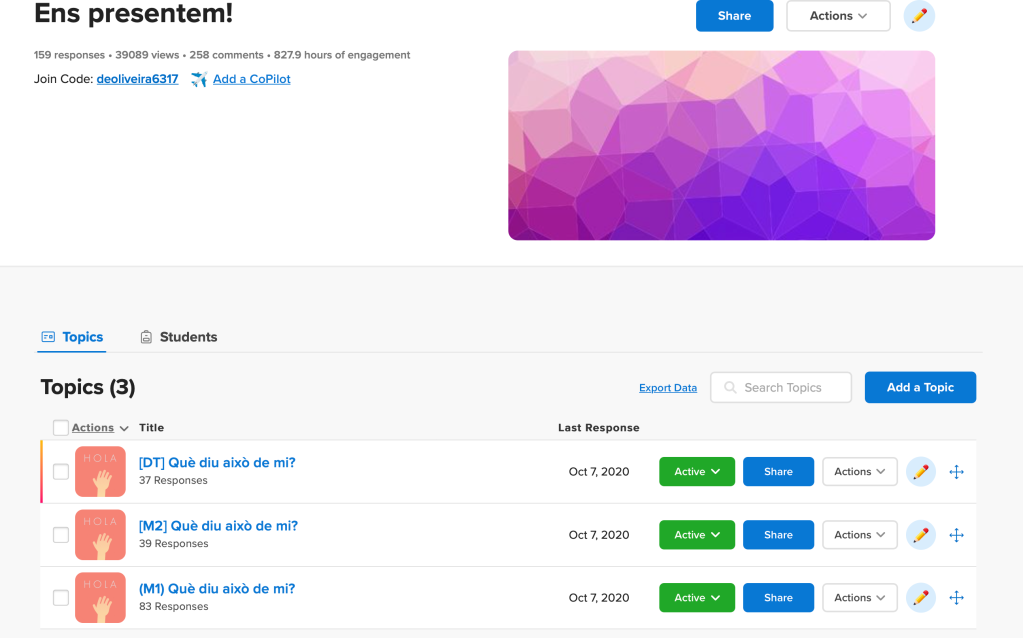
Well, world, let me just tell you in my classes I have students who do different sports: football, taikondo, swimming and synchronized swimming, skiing, paddle, figure skating, rowing, rhythmic gymnastics, twirling baton, high jump, basketball … I think we just don’t have people for a dance troupe because the styles are very varied: flamenco, jazz, ballet, sports dance, hip hop … We have at least two singers and two rappers – We are definitely going to record a battle. We have classmates who play the piano, the violin and the guitar. We have a magician. My students also belong to non profit associations and take an active part in the identity festivities of their towns.
Through the objects we have shown each other, we have shared our love for children, education and the opportunity to learn about new cultures. Some of us already have children, others feel very familiar and many of us like to take care of our beloved ones. We care about gender equity, we value creativity and freedom very much. We have cartoonists, we listen to a lot of music and we like reading. We are people with a strong character, positive, cheerful and we all want this pandemic to end soon to live college life in person.
My students can’t be prettier. I wish I could see them all singing, jumping, dancing, doing magic … Ken Robinson would be proud of them.
I am convinced that I have known things about them that would not have been possible if it were not for the pandemic. The current circumstances are an opportunity, a challenge. This is the way I chose to live it. And I’m loving it.
Hoping it is still November somewhere
I’m just hoping it’s still November wherever part of the world you are @edifiedlistener.
I just said goodbye to some friends who have had dinner home. Cultivating friends when you work as if you did not have children and have children as if you did not work is challenging. When they had left and I finished cleaning up I thought to myself, will I be able to write this? Yes, I have the feeling that I can do anything. I have inherited this from my grandmother, I do not know if she intended to leave me this legacy, but I have cultivated it this way in my heart.
She was born in 1915, a woman, poor, in a small town of Minas Gerais, Brazil. Her father had promised her that he would teach her to read, but he died before he had the chance. Over time, she learned to read and write. She grew up with the firm conviction that the freedom of women was in the books. He had 9 children, of which 5 lived, 4 women. At a time and in a place where a woman’s greatest ambition was to get married, my grandmother educated 4 teachers. He did it even though he became a widow when my mother had not yet turned one year old. She as a clothes washer. You can imagine that there were no washing machines then – or at least my candy didn’t have one. She took the ladies’ clothes in their homes and took them to her home where she had a well or to the river. That’s how she was able to support her family without ever getting married again and, still, send her girls to school.
My mother studied pedagogy when I was in my teens. She worked as a teacher in two different schools, in the morning and in the afternoon, and studied at night. It can be said that he did the Pedagogy undergraduate course in transit: he took the bus to go to university and went there imagining how the house was on fire … My brother (9) and I (12) were left alone at home. My mother used to get to college and turn around. He came home to find my brother and I playing quietly or watching television, and again she headed to college. By the time she got there, it was time to go home … Four years of our lives like this. I grew up listening to stories about my grandmother and watching my mother’s struggle. During her Pedagogy course, everyone at home learned about Paulo Freire. The pedagogy of freedom became a philosophy for us.
I studied English philology. I did my Phd in Applied Linguistics. I immigrated. I did not immigrate fleeing hunger or violence, I did not immigrate looking for better working conditions. I didn’t do it because I needed to, I did it because I could. I had, I have, I have always had the conviction that the person who has a good education can do what she wants, she can transform reality, she can move because she has tools to do it. I have them. I have earned them and I am happy about it. I’ve studied all my life in public education, ¡Attentions! In Brazil! There medium class and higher take their children to private school to have a good education and go to the best university, which is public. One more perversity / contradiction among many in a country where social inequality is abysmal and growing.
Today I work in a public university in Tarragona, Spain. I teach Communication Skills and tell my students that reading and writing well and critically are keys to social access and participation, although nowadays we must add components of multimodality and digital literacy. I transmit it with all the passion of my soul because what I would like is that each and every student of my students, in the future, could do what my grandmother did: transform the lives of generations to come by believing in the force of education.
This week in class, we discussed a document of the “No Hate speech” movement. It has been a magnificent class. A Mulsumana student, a gypsy and a bisexual student felt free to express the history of symbolic violence to which they had been exposed. I, the teacher, was the immigrant. The class rejected any use of language that moves away from tolerance, respect and solidarity. All this frantic movement in my life dresses in superior meaning when things like that happen … I love living, learning and teaching. In fact, it’s all the same, if you look carefully enough.
I wanted to write this. This month my cell phone and laptop have been stolen (on different days and in different places), I have taught classes, I have taken my baby to swimming and my girl to school, I have done two qualitative research methodology courses, I have had spiritual tasks in my philosophical community, and I have had friends over for dinner. Still, I wanted to write this. I just hope it’s still November where you are.
Thank you Old Traveler
Just returning from vacation, looking for information and bibliography on the Internet about multimodality, I learned through the Institute of Education website that Professor Gunther Kress had passed away. I write these lines as a way of mourning. I feel moved by the news, for the admiration I have for his intellectual legacy ands because of the personal impression he made on me . I realize as I write this that my own academic history has been intertwined with his at different crossings of my journey.
The first time I had the opportunity of listening to Gunther Kress, I was a UFMG graduate student. I have a post about this day. There were about 300 students in the auditorium. The way he defined learning was so interesting for me:
“The transformative engagement with an aspect of the world which is the focus of attention of an individual; on the basis of principles brought by her or him to that engagement; leading to a transformation of the individuals semiotic/conceptual resources”
Gunther became a reference for me in the years that followed, while writing the doctoral thesis. However, in the analysis of my data I opted for Halliday Systemic Linguistics – which, by the way, has also passed away- and multimodality remained in my mind as an attractive, unexplored way of analyzing images and video. I did a PhD in Brazil, but after finishing it I came to live in Barcelona. It was here, when I was already working in the Pedagogy Department of the Rovira i Virgili University, when Kress’s thinking began to really influence my way of seeing communication and education. I have post on that point of my carrear too.
Some years later, when the research group in which I participated ARGET organized an exciting international forum to reflect on education – FIET -, I invited Kress to come, but he declined. He was no longer interested in big meetings or passionate debates. He was already at a different point in his career. I accepted it but made him promise that one day he would come to Tarragona. He said yes. In 2018 I finally invited him again to come to Tarragona for a presentation at the Study Circle Education, Discourse and Society. I was pregnant then and it was before taking the leave for a strong lombalgia crisis. We only payed him the airplane tickets and the stay in a small hotel next to the beach. Gunther Kress accepted my invitation and came to our Faculty. He gave an inspiring talk attended by ONLY 5 people, me myself one of them – Surreal! Nothing compared to the 300 students of the Faculty of Letters in 2008. The URV Faculty of Education and Psychology, students and teachers, simply ignored the opportunity.
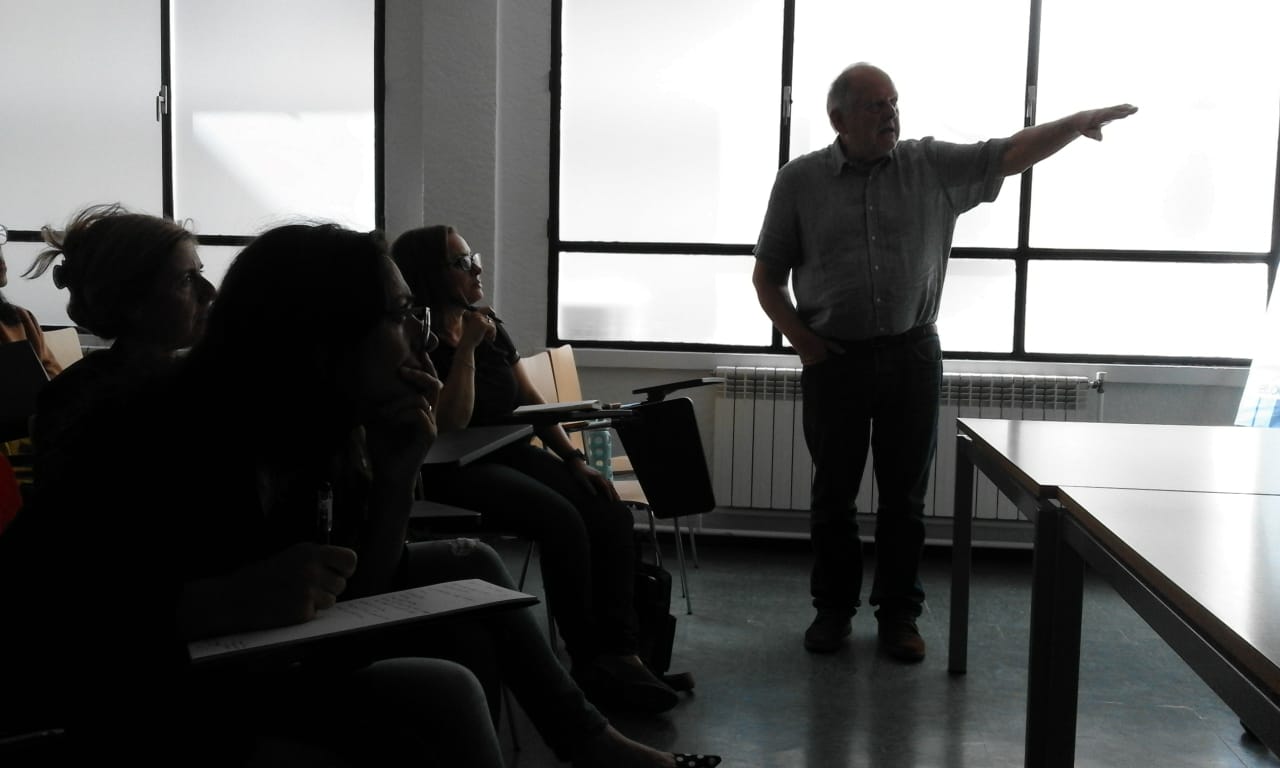
Gunther Kress at the FCEP – URV
On this occasion, I went pick Gunther up at the airport in Barcelona and took him to the hotel in Tarragona. I brought him back to the airport the day he left. The discussions we had on these two car journeys, plus the talk he gave at the FCEP will be forever in my memory. We also have the text that he generously published in our Faculty Jornal, Universitas Tarraconensis. I can only thank Gunther Kress for having been so influential in my vision of communication and education.
I was pregnant in this last meeting that I had the honor of having with Gunther Kress and he referred to my baby as “The little traveler”. Well … The Old Traveler has returned to the place where we all belong. I am looking forward for our next meeting.
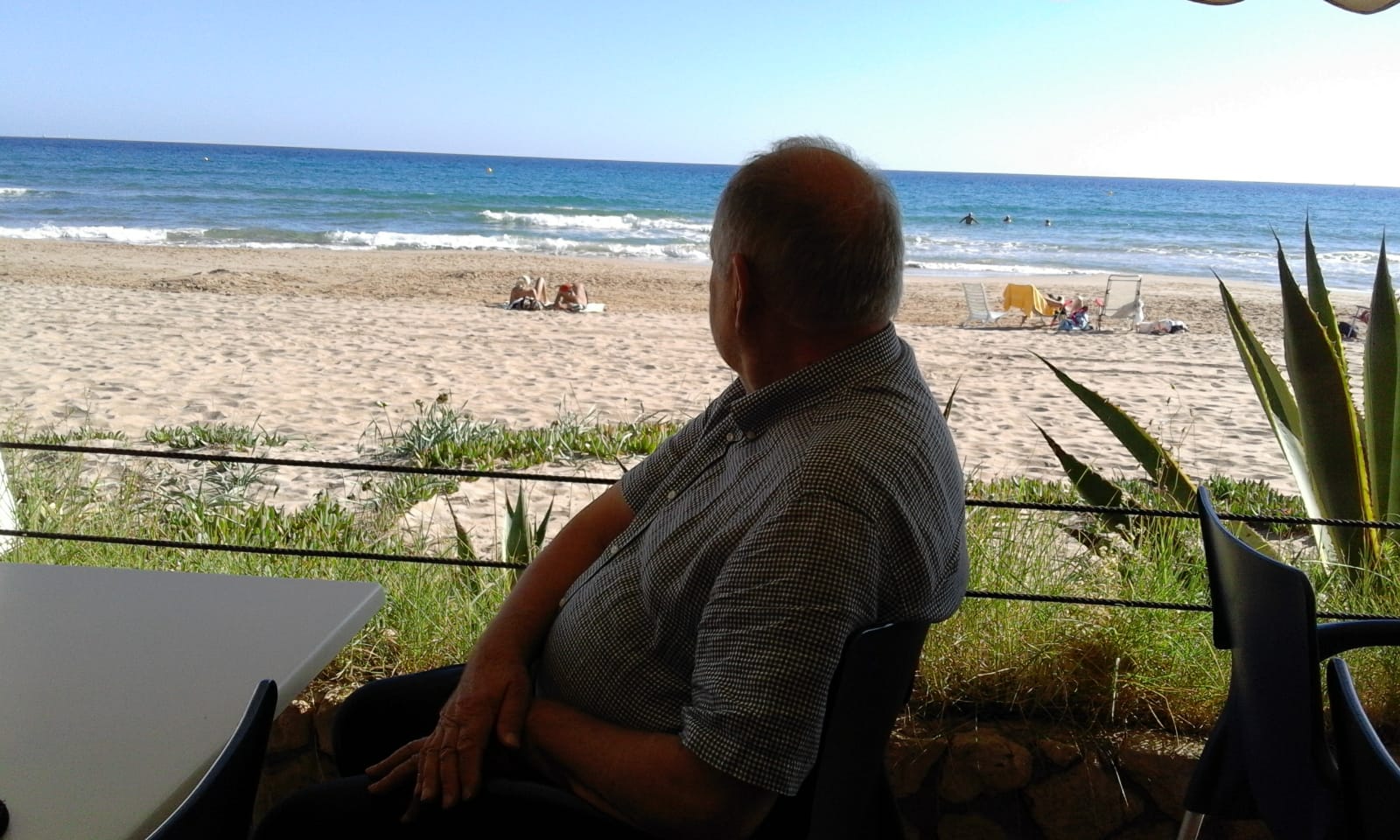
PS. I hope he doesn’t mind me sharing the photos I share here.
A Multimodal Approach to learning
I am an assotiate professor in the Department of Pedagogy of the Faculty of Sciences of Education and Psychology, @universitatURV. In my teaching, in addition to coordinating the subject “Communication Skills”, I teach the module “Multimodal literacy”. My students are first year students of the grades of Infant and Primary Education, Pedagogy and Social Education. For 15 weeks, I promote reflection around the sense of literacy today. I invite my students to rethink what it means to be literate today, what skills should the educator have today, what is communication and its relevance in pedagogical processes and what social, historical and political repercussions does the educator have Whether or not you are aware of issues like these.
Often when we start discussions, my students think that I want to hear that the multimodal approach is about the application of technologies to education – Students have a bad habit of trying to guess what teachers want them to say. Who’s taught them this? – My students also often say that multimodality seeks to combine elements of current methodology, teaching or technologies with “traditional” education. The coquetel molotov is served.
When I tell them that multimodal learning is not a methodology, but a way of thinking, they take notes in their notebooks. I see them at their 18-20’s, some even younger, and I remember myself, the student of Letters at the Federal University of Minas Gerais. I also thought I understood everything.
Multimodality, when applied to education, is a philosophy, a way of understanding how interaction is structured in communicative contexts by and through complex identity processes. Teaching is not transmitting information, but designing communicative events with pedagogical objectives that facilitate and challenge the thinking of students. Teaching is a design process, each choice you make is an exercise of power with social, political and historical implications. Learning is semiotic work, interpretation and knowledge editing. Learning is an active selection process. You don’t learn everything, you only learn what you want, though not always everything you want to.
I explain to my students that multimodal learning is not a methodology because it does not tell you how to structure learning. What it does is give you a way of understanding the world that makes you want the student to be the protagonist of the learning process, creator of his own discourse and aware of the forces that compete around him. If you share this way of understanding the world, you want your student to be able to search, select and analyze information critically. You also work so that your students know and manage the tools available in their time for the production and dissemination of meaning. You choose texts and promote discussions with the aim of making your students’ communication vision more complex, rather than simplified. You think it is worth digging, adding complexity, asking open-ended questions whose answers are neither easy nor clear.
I do not advocate technology in the classroom. What I want is a type of pedagogical design that draws on multiple forms of representation. I want my students to understand that literacy is, beyond teaching to read and write, to guide the reading of the world and to take position in it. I am not focused on tools. My priority interest is the processes, the pedagogical designs, the intentions, their staging, the sensations and experiences, the evaluation of them.
Obviously we need tools and denying our students learning through the technologies of their time is contributing to their marginalization. It is clear that different tools produce different effects and that they are not neutral or “passive objects”. Precisely for this reason I have begun to reject terms such as “mobile learning”, which assumes that having chosen the tool, we can now move on to the methodology. It doesn’t go like this: they don’t go separately. They influence each other and produce different effects according to the choices of educators and those of learners.
Pedagogical designs
A poor vision of communicative practices goes hand in hand with pedagogical designs focused on the figure of the teacher. The vision of communication as transmission concentrates maximum power in the hands of the information transmitter. He is the one who decides what is relevant to learn and believes that the fact that he exposes the content to the students is enough for them to learn. In fact, after exposing the information, what usually follow exams that supposedly determine the students’ success in assimilating the information that was presented to them.
More progressive pedagogical designs value active student participation as essential. When oriented and accompanied, students can search, select and analyze information. In addition, students do not only remain in the consumer role, but they may also produce knowledge, sharing the result of the interpretation processes developed during learning through texts that combine multiple modalities, such as verbal language, sound and images. In order for this to be a reality, the teacher must have a digital competence that allows him to gather, use and share with the students means and contemporary analogical and digital tools. When teachers act like this, they also contribute to the development of the digital competence of students by giving them the opportunity to participate in the knowledge society, while reducing the possibility of marginalization. This approach draws radically away from uses of technologies that do not transform power and creation relationships in the classroom.
The use of technology, whatever technology it is, is not justified as an end in itself. The kamikaze use of new tools is not an objetive. I do not define learning according to the resource we use, for example, I do not say mobile learning, book learning, pencil learning. Nor does the exaltation of pleasure and enjoyment in the learning process resonate in this approach. Can we use the latest tool for students to find classes enjoyable while they learn? Yes, we can do it, but sorry, it’s not what we’re talking about here. What we are really talking about is the transformation of the classroom in its foundations. I want pedagogical designs in which the student seeks, selects and analyzes information, integrates it into his previous heritage of knowledge, changes his worldview through dialogic processes, produces semiotic objects in which he shares what he has learned and finally shares it with social actors or communities that he believes that are relevant to his personal development. All this happens in environments marked by humanistic values such as friendship, solidarity, respect and love, in which hate speech finds complete rejection. Is it be utopia? I don’t think so, there are many people today doing things like that. I try every day, with more or less fortune. But I go on trying.
Learning informs choices and responds to interests
When we plan and carry out a pedagogical intervention we make choices in a huge range of alternatives. We choose the content, how to present it, what we will do and what the apprentices will do. Each of these choices says something about who we are and how we position ourselves in the world. In addition, these choices also give learners clues about how to interpret the information we share, but it does not condition them. They too, the apprentices, select from everything we offer what they want to learn. Their work is active even when they refuse to learn or participate. The choices of the apprentices will be different according to their interests, according to how mature they are and according to their previous knowledge. So teaching and learning are processes of design. A process that informs choices and responds to interests.

None of the choices we make, whether we teach, or when we learn, are neutral. In fact, the very fact of sharing or learning a system of representation, such as a language, for example, is an identity process. Learning a language transforms us because with this learning comes sociocultural and historical information. The way we see the world is transformed when we learn. Our interpretations of reality has more elements to realte to and, therefore, we should become more tolerant and humble people, aware that we will learn throughout life. You can accumulate information and believe yourself superior to others because you know a lot about a topic or you can integrate information and understand how much remains to be learned. These are critical professional awareness issues: what values and beliefs do I feed when I what to become or I am a teacher? I am aware that the classroom is a space for negotiating power and authority? Do I understand that each pedagogical design distributes or concentrates power?
What’s communication?
It is possible that the first thing that comes to mind if we ever ask ourselves this question is something similar to the transmission of information. Many of us know the communication models that tell us about the existence of a sender of the message, a receiver, a code, a means of communication and a message. These models undoubtedly identify essential elements in the communicative process, but it is not enough to explain it in its complexity.
This, however, leads us to another question: is it worth analyzing the communicative process in its complexity instead of staying with a more simplified notion? If you work or if you plan to work in the field of education, the answer is a resounding YES. Moreover, an educator committed to his own personal and professional development, and to social transformation, must reject simplistic views of communication processes.
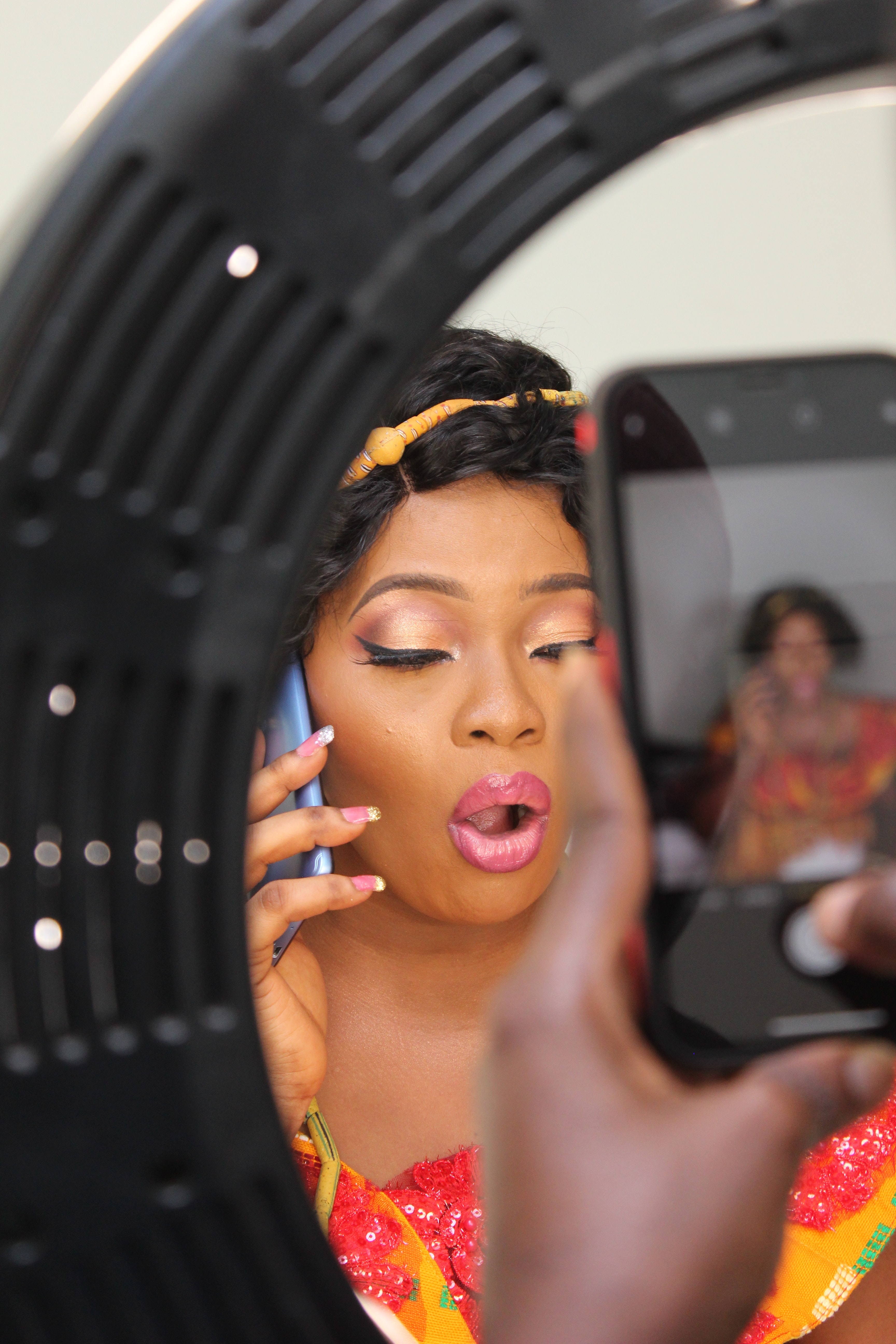
Much of the learning processes occur in and through communicative processes. Even when there is no physical educator formally shaping learning, if this person uses resources such as, for example, information on the internet, printed or digital books, mobile applications, dictionaries of any nature and in any format, it can be said that this person is in a communicative process. It happens that communication in our century allows us to communicate independently of the barriers of time and space. This is how we can learn from information shared by people months after they have made it available on the Internet; we can learn from people in simultaneous communication, but being located in different places of the globe; We can even send messages on topics that concern us through social networks. Each time information prepared with the objective of promoting learning is consumed, a communicative process is initiated whose participants can be, and often are, displaced in time and space.
Sometimes it happens that the information was not created for pedagogical purposes, that is, the person who created the resource we use to learn about something did not intende us to use it that way. It is possible that even a resource created with an intention be used for purposes that contradict the intention of who created them. However, can’t the same thing happen in communicative processes face to face? Something we say can be interpreted in different ways that we meant. People can use what we say or write very against our real intentions. Sometimes the messages we share orally or verbally cause effects that we did not anticipate, surprising us.
Let us note that, if this is so, if all the above is true, the simplification of the communicative process does not help to understand reality. If communication were the transmission of information, people would never misinterpret what we say. Someone who explained something to a group could be sure that all people would understand exactly the same. It would never be possible to use what we say against our interests. The problem of simplifying communication is the creation of at least two expectations that are not met. The first, that the issuer is the protagonist of the communicative act and, therefore, controls the understanding of the message; the second, that the receiver is a passive being, whose function is to receive information. Such is the vision of communication understood as the transmission of information, whose vocabulary uses terms of the Theory of Communication. The issuer, however, does not control the communicative act. Nor is he the protagonist. In fact, if we talk about the educational field and, let’s say, the sender is a teacher and the receiver is a student, by adopting progressive pedagogical positions, we would put the student at the center of the learning process. In this way, the receiver would be the protagonist and nothing could be further from the truth that he is a passive actor.

